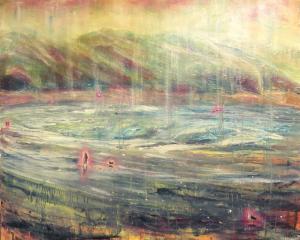In this week's Art Seen, James Dignan looks at exhibitions at the Blue Oyster Gallery, the Mint Gallery, and the Koru Gallery.
 The Insider (detail), by Tiger Murdoch.
''The Insider/Give Us This Day'', Tiger Murdoch and Teresa Andrew (Blue Oyster Gallery)
The Insider (detail), by Tiger Murdoch.
''The Insider/Give Us This Day'', Tiger Murdoch and Teresa Andrew (Blue Oyster Gallery)

Two exhibitions occupy the Blue Oyster Gallery. In one, Tiger Murdoch examine the notion of the outsider; in the other, Teresa Andrew reflects on healthcare and child poverty.
Andrew's display utilises objects related to healthcare and temporary storage, ranging from cardboard boxes to contraceptive pills. The items are strewn around the gallery, though the juxtapositions suggests inner order. The nutritional basics of life - bread, milk, canned vegetables - are recurring themes, as are instructional text books.
Two desks are filled with the health and personal paraphernalia of institutionalised life. The exhibition is summed up by a dictionary opened to two pages headed ''Unhealthy-Unnecessary'' and ''Unnoticed-Unruly'', a poignant piece of accidental but appropriate text.
Tiger Murdoch (the collaborative duo of Kelly Pretty and Matt Dowman) presents some overwhelming agitprop in the gallery's smaller room. The space is filled with posters displaying visual or textual socio-political messages. The different designs play off each other, creating dialogues relating to the place of the individual in a society which tries to shoehorn the outsider into a more comfortable, controllable package. A nearby work, relating to the Dunedin bomb scare in June makes the point clear. The creative outsider is often considered primarily as a threat.
 The Lab, by Luke Hancock
''Blocks/Edges'', Luke Hancock and Manu Berry (Mint Gallery)
The Lab, by Luke Hancock
''Blocks/Edges'', Luke Hancock and Manu Berry (Mint Gallery)

The latest exhibition at Mint Gallery presents a display from a new artist (Luke Hancock) and a well-known one (Manu Berry). The works, which are wildly different in style, create an intriguing interplay.
Berry's excellent woodblock prints are well-known in Dunedin; mixing strong sensibilities and an eye for architectural design with Western and Japanese influences, he presents here a series of images of Dunedin and Otago's grand buildings.
Works such as Fortune Theatre are particularly fine pieces, as is an image of First Church which, surprisingly and effectively, is presented complete with its current framework of scaffolding.
Hancock is far less well known, but his pieces are strong examples of minimalism, produced in a wide variety of media ranging from collage to watercolour to screen print. In one piece (which shows no small amount of chutzpah) he presents an assemblage of white paper and white card as a ''post art-world document''.
In a more orthodox work, 50%, Hancock looks to the influence of colour field artists such as Barnett Newman with a work in velvet and acrylic punctuated by a single thin white line.
Perhaps the most intriguing of Hancock's works are two prints, Protection and The Lab, created from the repeated placement of monochrome inked blocks on otherwise empty paper.
 ‘‘The Insider/Give Us This Day’’, Tiger Murdoch and Teresa Andrew (Blue Oyster Gallery)
''Kaori Jackson'', Kaori Jackson (Koru Gallery)
‘‘The Insider/Give Us This Day’’, Tiger Murdoch and Teresa Andrew (Blue Oyster Gallery)
''Kaori Jackson'', Kaori Jackson (Koru Gallery)

Kaori Jackson is a Japanese-New Zealand artist based in South Otago.
Her wildlife paintings, predominantly of New Zealand native birds, are simple yet charming pieces in oil on board, ranging from small isolated single birds painted against uncluttered backgrounds to more complex group images. The smaller works, which predominantly attempt to capture the personalities of individual birds, are largely successful.
They are helped by the bold use of circular and semicircular boards as their bases, a feature which may be a carry-over from the artist's frequent use of stones as painting surfaces (none of the stone works are present in the current exhibition).
In group works such as Morning Glory: Kereru and Nikau Palm, the artist manages to successfully capture the spirit of a group of playful birds in flight, allowing the strong verticals of the palms to create a rhythmic backdrop.
A convocation of tui and a family of owls are also well presented. The use of background vegetation is important to each of the works. A further impressive large work is a depiction of a group of fantails resting on opening flax pods.
Several non-bird works are also on display, the most notable being a group portrait of several lemurs, which seem as intent on studying the artist as she is on studying them.











![... we all become all of these things [installation view] (2025), by Megan Brady.](https://www.odt.co.nz/sites/default/files/styles/odt_landscape_small_related_stories/public/story/2025/03/1_we_all_become_all_of_thes.jpg?itok=SH-Q8KJZ)
